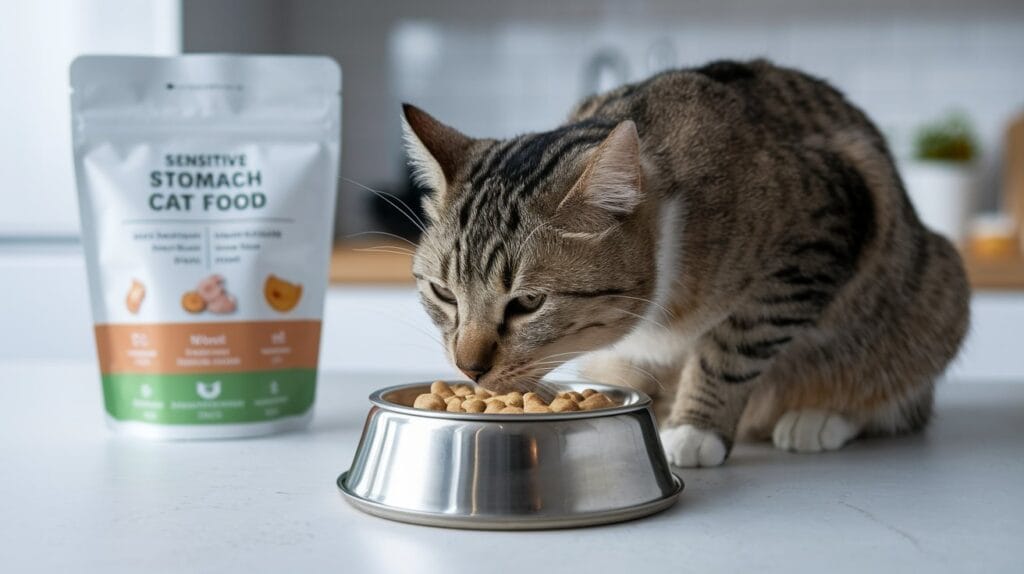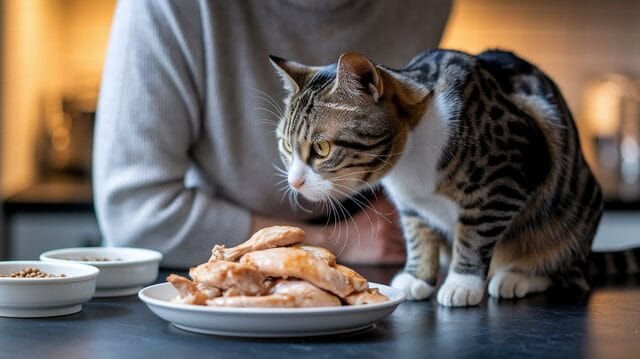
Understanding Sensitive Stomachs in Cats
If your cat is vomiting often, has soft or inconsistent stools, or shows disinterest in food, there’s a good chance their tummy is not as tough as it should be. Sensitive stomachs in cats are more common than many pet owners realize, and they require a gentle but informed approach to nutrition. This cat food for sensitive stomachs guide will walk you through what causes digestive upset, how to choose the right food, and the best feeding practices to support your cat’s health.
Common Symptoms of Digestive Sensitivity
Sensitive stomachs can show up in various ways. Watch for signs like:
- Frequent vomiting or regurgitation
- Soft stools or diarrhea
- Constipation or difficulty passing stool
- Loss of appetite
- Weight loss or low energy
- Excessive licking or grooming (often stress-related)
These symptoms are worth tracking and discussing with your vet.
Causes of Sensitive Stomachs in Cats
Many factors can lead to digestive issues:
- Food allergies or intolerances (e.g., dairy, beef, grains)
- Sudden changes in diet
- Low-quality food ingredients or fillers
- Parasites or infections
- Underlying health conditions like IBD or pancreatitis
Identifying the root cause helps you choose the right solution, starting with food.
When to See a Vet
Before switching foods on your own, always consult a veterinarian if:
- Vomiting or diarrhea lasts more than 24–48 hours
- There’s blood in the stool or vomit
- Your cat refuses food for over a day
- Weight loss is noticeable
A vet visit ensures there’s no serious illness causing your cat’s discomfort.
Key Nutritional Needs for Sensitive Stomachs
Importance of Easily Digestible Proteins
Cats are obligate carnivores and require high-protein diets. But for sensitive tummies, easily digestible protein sources like chicken, turkey, or duck are ideal. Avoid fatty meats or ambiguous sources like “meat by-products.”
Role of Fiber and Prebiotics
A small amount of fiber helps regulate digestion. Look for:
- Beet pulp
- Pumpkin
- Chicory root
These ingredients support good bacteria in the gut and improve stool consistency.
Avoiding Common Triggers (Grains, Additives, Dairy)
Many cats struggle with:
- Corn, wheat, or soy
- Dairy products
- Artificial preservatives (BHA/BHT)
- Food dyes and flavors
A limited ingredient diet with no fillers is best for sensitive cats.
Types of Cat Food Options
Wet vs. Dry: Which is Better for Sensitive Stomachs?
- Wet food is often easier to digest, with higher moisture content.
- Dry kibble can work if it’s high-quality and fiber-rich.
A mix of both or a rotation diet (as advised by a vet) works for many cats.
Limited Ingredient Diets
These contain:
- A single protein source (e.g., duck)
- A single carbohydrate source (e.g., pea)
- No fillers or artificial ingredients
Perfect for eliminating allergens and identifying triggers.
Novel Protein Sources (Duck, Rabbit, Venison)
Novel proteins are less likely to trigger allergic reactions. They’re ideal for elimination diets and help calm inflammation in sensitive guts.
Reading the Label: What to Look For
Ingredient Priorities for Sensitive Cats
First 3 ingredients should be:
- Whole protein source (e.g., deboned chicken)
- Digestible carbs (rice or sweet potato)
- Natural fiber or fat source
Avoiding Red Flags: Fillers, Preservatives, Artificial Colors
Skip any food that includes:
- “Animal digest”
- “Meat by-product meal”
- “Artificial flavor”
- “Corn gluten meal”
Cats need real, clean food just like humans do.
Top Recommended Cat Food Brands for Sensitive Stomachs
Hill’s Science Diet Sensitive Stomach & Skin
Vet-recommended, gentle on the stomach, and rich in omega-6s for coat health.
Blue Buffalo Sensitive Stomach Formula
Uses real chicken and brown rice, no corn or soy. Includes LifeSource Bits for immune health.
Purina Pro Plan Sensitive Skin & Stomach
Salmon-based protein, prebiotic fiber, and fortified with essential nutrients.
Royal Canin Digestive Care
Supports optimal stool quality and gut flora balance with specialized kibble shape.
Homemade Diets: Are They Safe?
Pros and Cons of Home Cooking for Cats
Pros:
- Complete control over ingredients
- Can tailor to specific allergies
Cons:
- Requires precise nutrient balance
- Risk of deficiencies without supplements
Always consult a vet or veterinary nutritionist if going this route.
Sample Vet-Approved Homemade Recipe
Ingredients:
- 1 lb. cooked chicken breast (shredded)
- ½ cup cooked pumpkin or sweet potato
- 1 tsp fish oil
- 1/4 tsp taurine supplement
Instructions: Mix all ingredients. Feed warm and store in fridge for 3 days max.
Transitioning to New Cat Food Safely
Gradual Food Switching Schedule
Days 1–2: 75% old, 25% new
Days 3–4: 50% old, 50% new
Days 5–6: 25% old, 75% new
Day 7: 100% new food
Monitoring for Signs of Improvement or Reactions
Watch for:
- Reduced vomiting
- Firmer stools
- More energy
- Less grooming due to irritation
If symptoms worsen, pause and consult your vet.
Feeding Tips for Cats with Digestive Issues
Portion Control and Feeding Frequency
- Feed 2–3 smaller meals per day
- Avoid free-feeding which may trigger overeating and vomiting
Hydration and Water Intake Importance
- Use water fountains to encourage drinking
- Mix wet and dry food to increase moisture intake
Using Food Puzzles and Slow Feeders
These slow down fast eaters and improve digestion. Bonus: they stimulate your cat mentally too.
FAQs About Sensitive Cat Diets
Q1: How do I know if my cat needs sensitive stomach food?
A: Signs include vomiting, diarrhea, or inconsistent stools that persist beyond a few days.
Q2: Should I only feed wet food for sensitive stomachs?
A: Wet food can help, but quality dry food with the right ingredients also works well.
Q3: Can cats grow out of sensitive stomachs?
A: Sometimes. Especially if it’s diet-related or caused by early dietary mistakes.
Q4: Is grain-free always better?
A: Not necessarily. It’s better to focus on ingredient quality and digestibility.
Q5: How long should I try a new food before deciding it works?
A: Give it 2–3 weeks unless symptoms worsen immediately.
Q6: Are prescription diets necessary?
A: Only if recommended by your vet. Many over-the-counter sensitive formulas are highly effective.
Also Read - Is Vaseline Safe for Cats? The Truth About Petroleum Jelly and Feline Care
Conclusion: Happier Tummies, Healthier Cats
Choosing the right cat food for sensitive stomachs doesn’t have to be overwhelming. With a little knowledge about ingredients, feeding strategies, and your cat’s individual needs, you can dramatically improve their quality of life. Whether you go with a high-quality commercial formula or a vet-guided homemade diet, always prioritize what makes your cat feel their best. A calm belly leads to a happier, healthier kitty—and a much more peaceful home.




